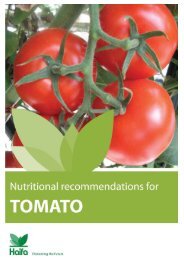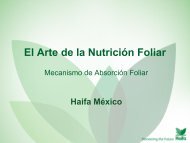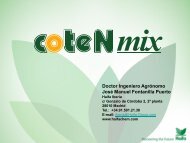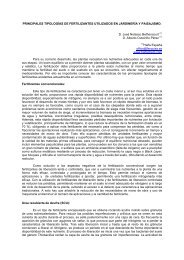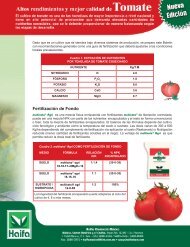Crop Guide: Nutritional recommendations for Cucumber - Haifa-Group
Crop Guide: Nutritional recommendations for Cucumber - Haifa-Group
Crop Guide: Nutritional recommendations for Cucumber - Haifa-Group
Create successful ePaper yourself
Turn your PDF publications into a flip-book with our unique Google optimized e-Paper software.
Nutrient Uptake (kg/ha)<br />
1000<br />
800<br />
600<br />
400<br />
200<br />
0<br />
300<br />
greenhouse<br />
30-50<br />
open-field<br />
Figure 3.11: N-P-K uptake rates by cucumber crops at various growing conditions and yields.<br />
Table 3.5: Indicative N-P-K ratios at various growing conditions (La Malfa, 1992)<br />
Open Field Greenhouse<br />
Expected yield (Ton/ha) 15 – 30 120 - 300<br />
Typical N:P:K ratio 1:0.5:1.5 1:0.5:2<br />
High concentrations of K are found in various plant parts, and serve as a method to assess crop<br />
nutritional status. On a whole organ basis, potassium is generally equally distributed between roots<br />
and shoots.<br />
Table 3.6: Leaf analysis potassium standards <strong>for</strong> field-grown cucumbers (in dry matter of youngest<br />
fully mature leaf with petiole taken at early flowering stage).<br />
Nutrient Unit Deficient Low Normal High Excessive<br />
Potassium (K) % 5.0<br />
Normal levels in petiole sap are 3,500 – 5,000 ppm K.<br />
Yield (ton/ha)<br />
The accumulation of K in stems, petioles and leaves correlates with the growth curve of these<br />
organs; this suggests a mechanism that balances K uptake and release. K accumulates rapidly in<br />
each leaf during its early developmental stage (Figure 3.12). The overall demand of the plant leaves<br />
creates there<strong>for</strong>e a sigmoid ascending curve.<br />
32<br />
30<br />
open-field<br />
N<br />
P2O5<br />
K20<br />
15<br />
open-field




